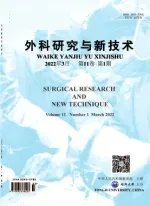Clinical study of correction of finger flexion deformity in Dupuytren's disease
2011-08-15ShenZunli沈尊理DepPlastSurgShanghailstPeoplHospShanghaiJiaotongUnivShanghai200080ChinAesthPlastSurg20102112725727
Shen Zunli,(沈尊理 Dep Plast Surg,Shanghai lst Peopl Hosp,Shanghai Jiaotong Univ,Shanghai 200080)…∥Chin J Aesth Plast Surg.-2010,21(12).-725 ~727
Clinical study of correction of finger flexion deformity in Dupuytren's disease
Shen Zunli,(沈尊理 Dep Plast Surg,Shanghai lst Peopl Hosp,Shanghai Jiaotong Univ,Shanghai 200080)…∥Chin J Aesth Plast Surg.-2010,21(12).-725 ~727
ObjectiveTo explore surgical technique and its result in correcting finger contracture in Dupuytren's disease.MethodsSeventeen cases of Dupuytren's disease with 58 years mean age were studied in this group(15 males and 2 females).Among them,8 sides were with flexion eontracture of little finger,8 sides with flexion contracture of little and ring fingers,1 side with flexion contracture of middle and ring fingers,2 cases with flexion contracture of middle finger.They were corrected by excising contracted aponeurosis and tissue around it in 5 mm though zigzag incision designed along longitudinal axis of pahnar aponeurosis contracture cord,then loosening contracted tissue around finger joint with slight finger joint to make fingers in straight position.Plaster slab braking was performed at the 2 weeks postoperatively.ResultsAfter 6~24 months follow-up.All zigzag flaps survived without nerves and tendon injuries except for 2 cases with circulation crisis at flap tip which was healed with dressing change.There was no recurrence of finger flexion contracture.The recovery rate of flexion and extension of finger was 100%.ConclusionThe finger contractures caused by Dupuytren's disease could be corrected effectively by completely removing and releasing of the diseased fascia through multiple zigzag incisions.Care should be taken to protect blood supply of the flaps and digital nerves as well as arteries to avoid complications.15 refs,3 figs
(Authors)
杂志排行
外科研究与新技术的其它文章
- Length of warm ischemic tolerance for epithelial regeneration in heterotopic rat tracheal isog-rafts
- Expression of bradykinin as a substrate of CD26/DPP IV in rats ischemia/reperfusion injury following lung transplantation
- Apoptosis and oxidative injury of donor islets during isolatio
- Efficacy of rituximab-containing regimens on post-transplantation lymphoproliferative disorder following haploidentical hematopoietic stem cell trans-plantatio: reor f 3 css
- Ailogeneic hematopoietic cell transplantation for malignant hematological diseases in patients older than 50 yers of g
- Clinical analysis of 100 cases of lung transplantation for end-stage palmonary disease
